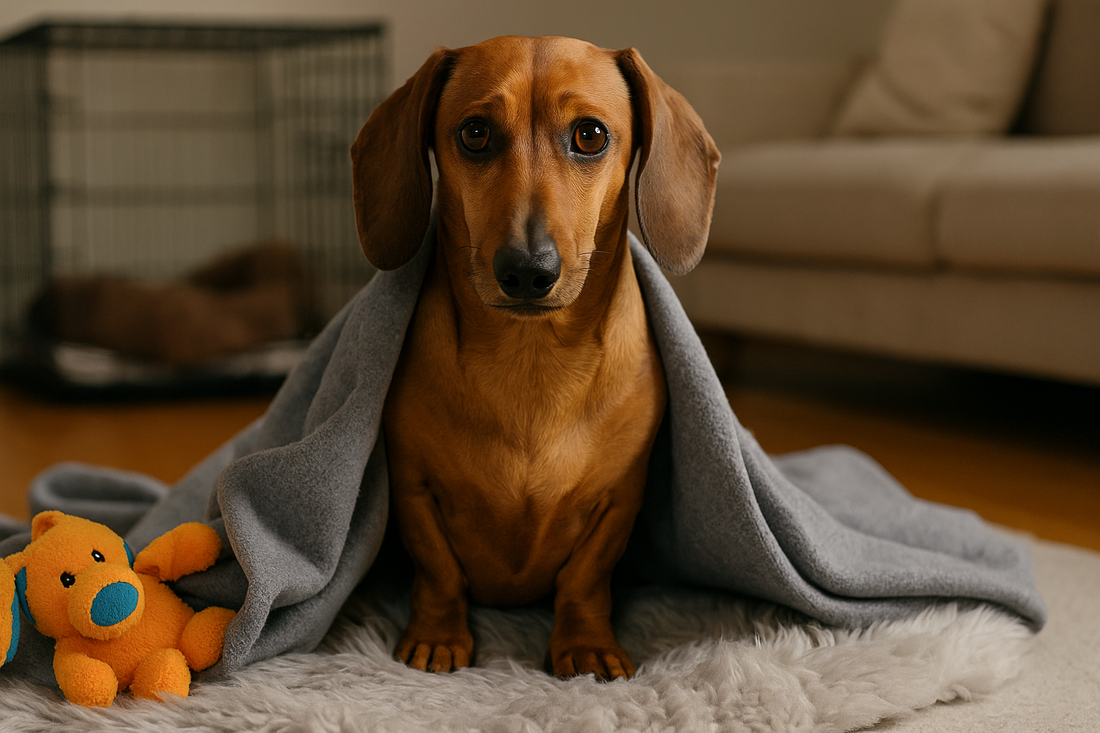
Home Alone No More: Calming Your Dachshund’s Separation Anxiety for a Happy Pup
Compartir
You step out, and your sweet Doxie turns into a howling, chewing whirlwind. Dachshund separation anxiety isn’t just tough on them—it’s heartbreaking for you, too.
Dachshunds are brave, clever, and fiercely loyal—but that loyalty comes with a catch: they hate being alone. Their pack-loving nature means solo time can trigger barking, pacing, or destructive behavior. Tackling separation anxiety isn’t just about your couch cushions; it’s about your pup’s emotional well-being. When your Doxie feels secure, they’re happier, healthier, and more fun to be around. And yes, that also means you can leave the house without guilt or chaos. 🐾
🎧 Listen to the Latest Episode about Calming Your Dachshund Separation Anxiety
1. Create a Comfort Zone with Familiar Scents
Creating a safe, cozy space is one of the most effective ways to help manage Dachshund separation anxiety. These little dogs are incredibly scent-oriented. The smell of their favorite human can instantly provide a calming effect. Before you leave home, place a blanket, recently worn shirt, or a soft item that smells like you in their designated resting spot. This familiar scent tells your Doxie, “you’re safe, even when I’m not here.”
Choose a quiet area in the home where your Dachshund already feels comfortable—perhaps a favorite corner, their crate, or a sunny windowsill. Add a soft dog bed, a burrow blanket, and a couple of toys they already love. Avoid using new items right before you leave, as the unfamiliarity can increase stress.
This “comfort zone” shouldn’t be used only when you’re out—it should be available at all times. That way, your pup associates it with safety and calm, not just your absence.
🎁 Pro Tip: Check out our Dachshund Blanket for Indoor and Outdoor use – Designed for Doxies who love to snuggle and feel safe. It holds your scent and mimics the warmth of a cuddle.
Providing a designated comfort zone helps reduce feelings of abandonment and gives your Dachshund a sensory connection to you, even when you're not home.
2. Practice Calm Goodbyes and Hellos
When it comes to separation anxiety in Dachshunds, your goodbye and hello rituals make a big impact. These smart, sensitive pups feed off your emotional energy. If your departure is filled with cuddles, baby talk, or obvious signs that something’s “different,” it can trigger their stress. Instead, act like it’s no big deal—and do the same when you return.
Here’s how: 10–15 minutes before leaving, reduce interactions. Let your Dachshund relax in their comfort zone, and avoid saying long goodbyes. When it’s time to go, just walk out calmly. When you come back, wait a few minutes before giving attention. This teaches your pup that your comings and goings aren’t something to worry about.
Also, try using “departure cues” without actually leaving—like picking up your keys or putting on shoes—so they stop associating those actions with anxiety. It’s all about desensitization.
Practicing neutral greetings and departures helps regulate your dog’s emotional spikes. Over time, your Dachshund will become more confident and less reactive to being alone.
Consistency is key. You’re building trust—showing your pup that you always come back, and that being alone doesn’t mean being forgotten.
3. Use Calming Chews or Toys During Absences
Mental stimulation plays a major role in easing Dachshund separation anxiety. A bored pup is a stressed pup. Keep your Doxie occupied when you’re away with calming chews or interactive toys that engage their brain and taste buds.
Toys that can be stuffed with treats (like peanut butter or soft chews) give your Dachshund a satisfying activity to focus on. Puzzle toys that require problem-solving can keep them engaged for longer periods, reducing the amount of time they spend worrying about your absence.
Another smart option? Natural calming treats formulated for dogs. Look for ones with gentle ingredients like chamomile, melatonin, or hemp, specifically sized for small breeds. They can help take the edge off just enough to prevent pacing, barking, or whining.
If you’re introducing a new toy or treat, do it while you’re still home at first. Let your pup associate these items with happy, calm moments—not just your absence.
🎁 Pro Tip: Check out our Dachshund Duck Toy– Soft Interactive Plush Squeaky Toy – Quack up your pup’s playtime with this adorable Dachshund Duck Toy — a fun and functional companion that keeps your Doxie engaged, active, and happy! 🦴
These tools don’t just distract—they provide comfort and stimulation that make solo time more enjoyable for your Doxie.
4. Establish a Predictable Routine
If your Dachshund suffers from separation anxiety, establishing a routine can work wonders. Dogs, especially Doxies, are creatures of habit. Predictable daily activities help them understand what to expect, creating a sense of control and stability in their environment.
Start by sticking to consistent times for meals, bathroom breaks, walks, and bedtime. Try to keep your departures and returns at the same time each day. This regularity reduces stress because your dog begins to recognize a rhythm in their day—even when you’re not part of it.
Include quality time in your routine, too. Play, snuggle, or go for a sniff-filled walk before leaving the house. This not only burns off nervous energy but also gives your pup a positive connection to your time together. Afterward, they’ll be more ready to settle in and relax.
On days when your schedule changes, try to maintain at least some of the regular markers (like breakfast or playtime) to minimize the disruption.
A stable routine sends the message: “You’re safe. This is normal.” Over time, your Dachshund will feel more confident navigating solo time, knowing you’ll return just as predictably as always.
5. Try Gradual Alone-Time Training
One of the most effective long-term solutions for Dachshund separation anxiety is gradual alone-time training. Think of it as building your pup’s confidence muscle—slowly, kindly, and at their pace.
Start small. Leave the room for a few seconds and return before your dog starts to worry. Praise calm behavior. Then build up to one minute, five minutes, ten minutes, and beyond. The goal is for your Dachshund to realize that your absence is temporary—and not a big deal.
Be consistent. Use the same departure cues (like grabbing your bag or keys) so your dog begins to associate those cues with short, non-scary absences. If your dog panics when you reach a certain time threshold, shorten it again. This process isn’t linear—but with patience, it works.
Pair these sessions with something positive: a chew toy, background music, or even a treat. That way, alone time becomes associated with good things, not just your absence.
This training takes commitment, but it lays the foundation for long-term independence. You’re helping your pup build resilience—and creating a calmer home for both of you.
Conclusion
Your Dachshund’s separation anxiety doesn’t have to run the show. With a little planning and patience, you can teach your pup that being alone is okay. Stick to routines, offer comfort, and introduce tools that make solo time feel safe. You’ll both enjoy more peace of mind—and more joyful reunions. 😊
Related Articles
- 20 Things About Dachshund Every Owner Should Know
- Best Calming Products for Anxious Dachshunds
- How to Crate Train a Dachshund the Gentle Way
👉 For more Dachshund wellness tips and clever gear, visit our blog at Doxie Blog
